Age of Sigmar Soulbound from Cubicle 7 is a game that’s all about heroic adventurers taking on the evils of the world in a bitter fight for the fate of the Mortal Realms themselves. But what’s a hero without a good (bad?) villain for them to take on? Today, we’re reviewing the AoS Soulbound Bestiary, a beautifully illustrated 192-page collection of the various beings that have managed to survive the harsh conditions of the Mortal Realms, making them quite the force to be reckoned with.
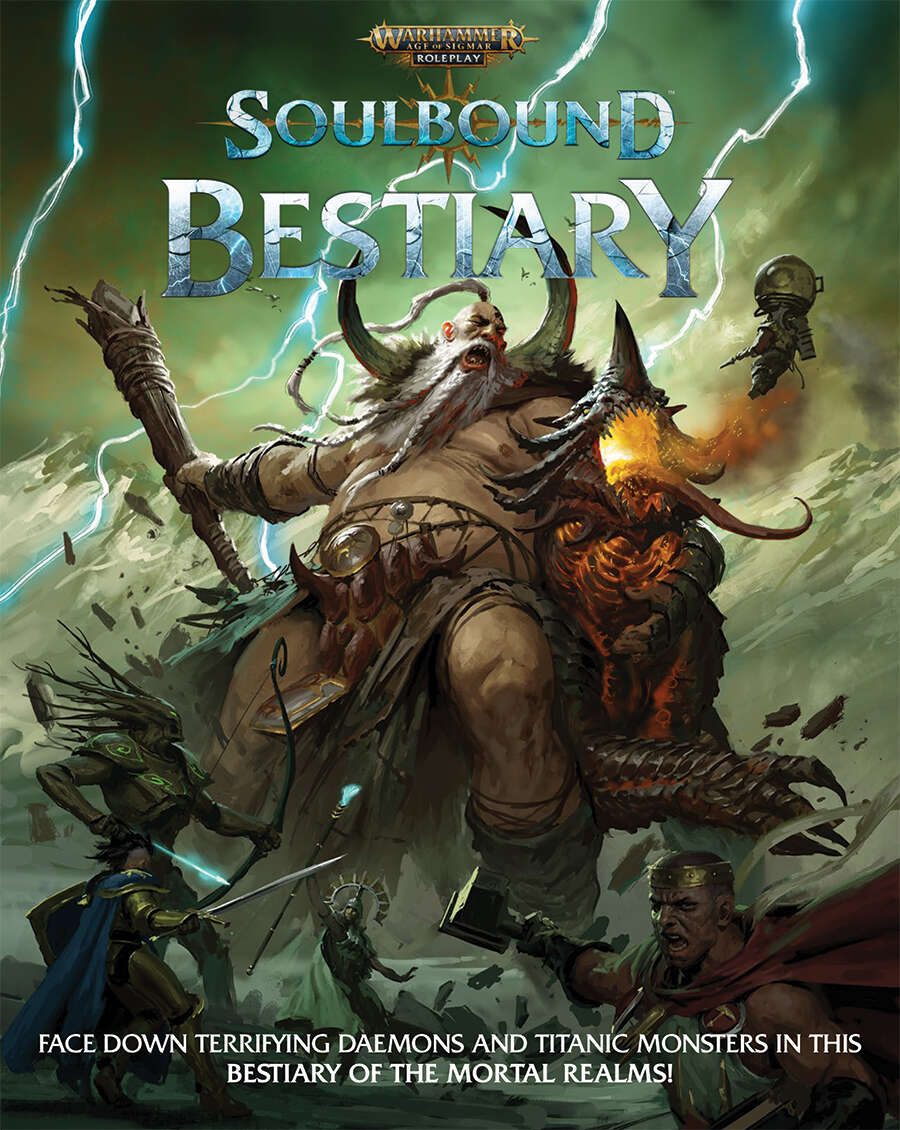
Bugbears begone
No, not those bugbears (though, I suppose, yes, also those bugbears).
Before we get into the beasties themselves, the supplement starts with an advice section full of juicy morsels for Gamemasters preparing an encounter. It repeats some aspects of the core rulebook, such as how to read a stat block and what the different bits of jargon mean. It’s a helpful reminder here, as it avoids referencing another book if you forget something. It also reminds us of the four different “creature roles” possible in progressive levels of power: minions, warriors, champions, and chosen. This role is essential in evaluating a creature’s strength at a glance, and a quick look at the creature’s stats and abilities should give you a good idea of how they are meant to be played in a fight.
Speaking of evaluating power, one of my complaints when I originally reviewed the Soulbound core rulebook was that for such a combat-focused TTRPG, there was very little to help the GM decide what would be a reasonable fight. Well, the bestiary has that covered. It provides a template for an encounter depending on how much experience your characters have, saying how many minions, warriors, champions and chosen is a sound basis. Now, this obviously doesn’t cover all possible bases, but to be fair to the designers, I think it’s about as good as you can get without getting into such a level of byzantine complexity that no one would use it. It’s just enough to help a starting GM set up the initial fights, and then they can adjust as necessary as they get to know the system better. It’s simple and effective, and I appreciate that, especially since the game is quite forgiving towards mistakes.
This section also includes a table of complications that can be added to your encounters to make them more engaging, whether due to environmental factors, various missions the party must undertake, or the tactical considerations of the monsters they are fighting. This makes building an encounter on the fly incredibly easy and is great for inspiration purposes. The section calls out that this should be the standard and not the exception, with every fight including some sort of condition to it. Fights in Souldbound are never just a pitched battle between the creatures and the PCs but should be fluid and constantly moving, really pushing the heroic fantasy aspects of the game.
This chapter is overall very helpful in getting the most out of the rest of the book, and I’m overjoyed that they decided to put it front and centre, rather than hiding it at the back as “GM info” that would get a lot less attention and would have led to much more confusion since it includes pretty much essential information. These few pages of introduction (along with the expanded roster of enemies to throw at the PCs) solve most of the main issues I had with AoS Soulbound after reviewing the core book.
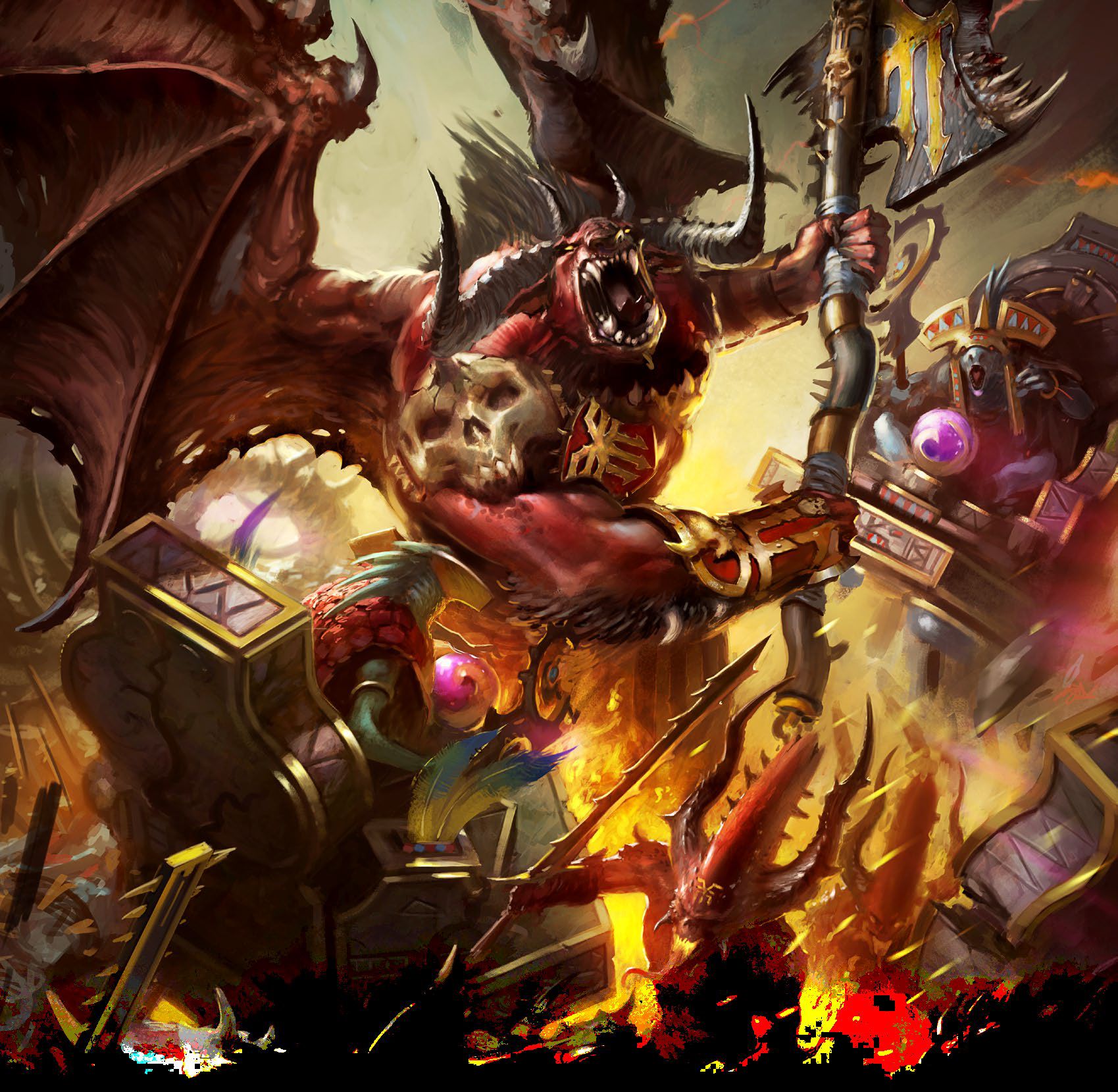
The many faces of the realms
The bestiary adds over 180 creatures to liven up your encounters, split up into various groupings that fans of the tabletop wargame will easily recognize as the different factions:
- Cities of Sigmar & Forces of Order (a bit of a mix of the Age of Sigmar factions on the “Order” side of things, which is reasonable since these are generally more likely to be allies rather than enemies like the rest of the listing here)
- Monsters and Beasts (the non-sentient creatures that haven’t been put elsewhere)
- Seraphon (lizardfolk and dinosaurs)
- Beasts of Chaos (half-human half-animal chaos worshipers)
- The different demonic creatures of the Chaos factions (Blades of Khorne, Disciples of Tzeentch, Hedonites of Slaanesh, and Maggotkin of Nurgle).
- Skaven (ratfolk)
- Slaves to Darkness (the human chaos worshippers)
- Flesh-Eater Courts (ghoul scavengers)
- Soulblight Gravelords (vampires and their subjects)
- Nighthaunts (ghosts)
- Ossiarch Bonereapers (bone constructs)
- Gloomspite Gitz (goblins)
- Ogor Mawtribes (ogres)
- Orruk Warclans (orks)
- Sons of Behemat (giants)
If you don’t know much about Age of Sigmar, then don’t let my brief descriptions above fool you. The names aren’t just blatant attempts at copyright protection. Most of these factions have specific attitudes and sub-factions to make them unique to the mortal realms, not just generic fantasy creatures. The Seraphon live in space pyramids and teleport to the mortal realms, the Gloomspite Gitzs worship the moon and the power of ‘shrooms, the Skaven mix techno-sorcery with sheer numbers, and the Flesh-Eater Courts live as powerful nobles in their imagination while, in reality, they scavenge battlefields for carrion. For each faction, you will find entries covering the most emblematic and representative members of various power levels, from minions to the chosen. Along with the creatures in the core rulebook, you’ll have plenty of choice in enemies for your campaign.
Most entries also have accompanying artwork, which is just gorgeous. They capture the world and the creatures perfectly and slide excellently into the artwork put out by Games Workshop, making for a unified style. Even for the few entries that don’t have artwork, one of the advantages of being brought from a miniatures wargame is that you can always look up the model for the wargame on the website. You’ll never be without at least some visual representation of the creature in question.
At the start of each section, there is a general presentation of the faction’s main aspects (and how to use them in play, but we’ll get to that later), and each creature entry also has a paragraph of lore associated with it. If you know very little about AoS, sometimes this lore can be a bit limited or confusing, requiring you to dig a bit deeper into certain aspects. Still, for the most part, the book can be used in a self-contained manner, with occasional references to the core rulebook. If you have a passing knowledge of the world, you should be just fine navigating the lore in these pages and have everything fit together without much trouble. Of course, a bestiary is much more than just lore, so how do the creatures themselves stack up?
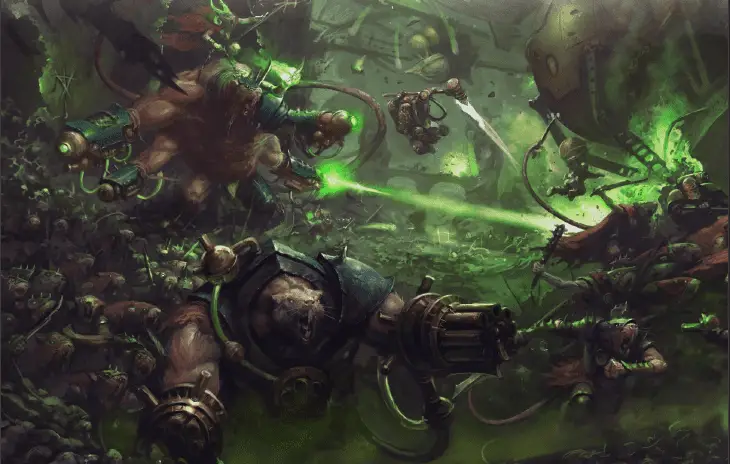
Action!
Once you’ve got through the lore section, you’ll be right into the stat blocks. Personally, I prefer to have lore and stat blocks together, but this does at least mean that you’ll generally have fewer pages to flip through in an encounter, which is pretty crucial in this case, as I’ll get into later. Firstly, however, we need to spend a bit of time looking at the stat blocks themselves. This is one of those cases where you can really feel the wargaming influence in the best way possible. The stat blocks are incredibly legible, thanks to their simplicity and clarity of design that puts the required information front and centre, allowing the eye to quickly pick up whatever it needs at speed once you’ve got a bit of practice in.
Each stat block lists the creature’s possible attacks and traits, and every single creature, even the lowliest minion, has at least one trait associated with it. Occasionally, this trait will be generic (the spider’s ability to climb walls jumps to mind) and won’t be very important. However, most of them make the creature come to life and ensure that, yet again, as with the complications presented at the start of the book, you will rarely have a simple static pitched battle. They are also excellent at tying a faction together. For example, nearly all the powerful Blades of Khorne have the “Blood for the Blood God” trait, boosting their power around wounded creatures as they go into a frenzy. There are also little sidebars about adapting a stat block to fit another role, suggesting what traits to swap out. This seems like a good compromise for adding in more options while still working within a page limit, though I recommend making your own stat block in this case for use at the table, so you don’t have to look through the entire book to find out what a trait does in the middle of a fight.
Generally, more powerful creatures (Champions and Chosen) will have more traits and possible attacks than the lesser ones (Minions and Warriors). This helps somewhat to alleviate the amount of work for the GM as they track the forces they are controlling. This is important as it’s expected that the party of heroes will be fighting many creatures at a time. The fact that minions can be put together in a swarm also cuts down on bookkeeping effectively and keeps combat moving along well. It might seem daunting at first, but you’ll quickly get the flow of it and find your way of tracking these different abilities. I took to printing out the blocks on strips of paper and using them as both a quick reference sheet and to track initiative.
The bestiary also does a beautiful job of bridging the gap between lore and combat. The introduction to each faction also includes a “how to use them in combat” section, describing what tactics they might employ in the field. Not only does this help a newer GM get a hand on the faction and integrate world-building elements into combat, but it also reduces the mental strain on running combat, as you can default to how the faction generally reacts in a fight. I find that this also helps fight against my own “optimized” instincts in certain battles. At the table, my players will sometimes think I’m going easy on them if I don’t play the creatures they’re fighting as tactically competent, but while a Khorne berserker might be a hardened battle warrior, at some point, they just want to hit the nearest creature, rather than go for the squishys at the back, and it’s nice to have a book to back up that instinct. On the flip side, if you have trouble figuring out battle tactics, you have a solid base to work from, thanks to the introductory paragraphs.
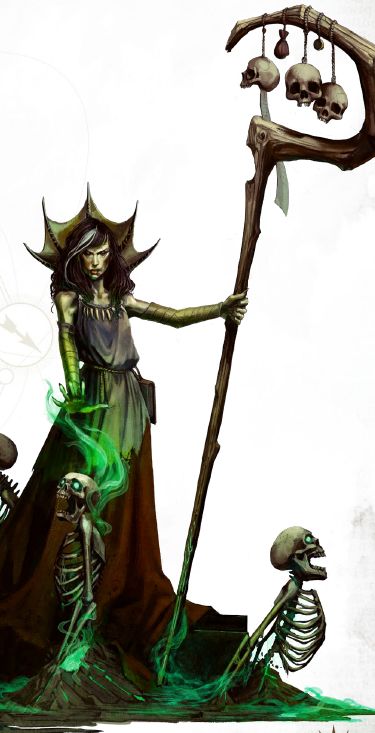
Taking damage
This is an excellent bestiary, but I’d be remiss if I didn’t mention its flaws. Actually, that should be flaw, singular, as there’s only really one, and that is its organization. This is starting to be systematic with Cubicle 7 publications, so maybe I’m being overly harsh. Still, at some point, I’d like to be able to reliably find the creature I want without having to systematically refer to the index. Let’s go into the problems a bit.
The different creature entries are broken down into their respective factions. I understand the principle behind this. As a rule, you’re going to be using creatures from the same faction most of the time, so this reduces the amount of flipping about in the book required for most encounters. This presentation is fine if you already know AoS. You’ll be able to tell if the creature in question is a member of the Gloomspire Gitz or the Orruk Warclans simply because you know the world. The problems start if you’re not as versed in the AoS lore, however, as you’ll have to memorize who is in which part.
There are also edge cases where even with knowledge of the system, it’s a bit of a guessing game to know where they are. The most obvious examples are in the “Monsters and Beasts” section, where you will find animals generally associated with another faction grouped up with the more generic creatures. If it were systematic, that wouldn’t be so much of a concern, but it’s not. The lizard/dinosaurs are with the Seraphon, and the cockatrice and chimera are with the Beasts of Chaos, but the Stonehorn and Thundertusk are in the Monsters section, rather than the Ogors. It’s all just a bit confusing.
It doesn’t stop there, though. Inside the factions themselves, there doesn’t appear to be any discernable order to the entries. They aren’t in alphabetical order or order of power rating. In fact, the stat blocks aren’t even always in the same order as the lore paragraphs. Is it a significant fault? Probably not. Most of the time, you’re going to be flipping between at most twenty entries to find the one you want (if you’ve got the right section), and then once you’ve got the ones you need for your encounter, you’re fine. It’s just that it’s that bit more annoying than it needs to be, especially when trying to keep things flowing at the table, which is very much the style expected around the free form and fast-flowing combats.
While I’m getting my gripes in, it would also have been nice to have a list of traits in an annexe at the back of the book. The sidebars in the bestiary reference different traits to help adapt a stat block to your needs, but you then need to find another stat block that uses the new trait to figure out what it does. Again, not significant, but along with occasionally having to refer to the stat blocks in the core rulebook that aren’t reproduced in the bestiary, it can bog down the action, and you’ll need to find a way of keeping everything organized.
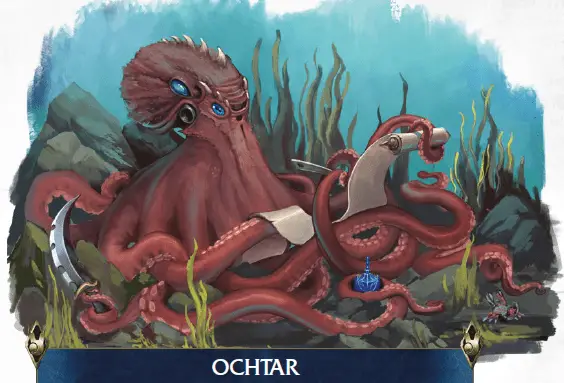
Final encounters
Despite the last few paragraphs of quibbling, this is pretty much everything you’d want from a bestiary for AoS Soulbound. Soulbound wants you to tell the story of valiant heroes defeating vile villains. The core rulebook did well on the hero side, but the equation couldn’t be satisfactorily resolved without the villains. With the bestiary, that’s changed. It provides a varied range of everything you need to flesh out the denizens of the Mortal Realms, with succinct lore and clear stat blocks.
While the organization is not optimal, the rest of the book is designed to make combat as easy to run as possible and help it run fluidly, emphasizing the movement and almost cinematic quality of a Soulbound engagement. The bestiary feels like a must buy if you want to run any substantial AoS Soulbound campaign.
You can grab the Age of Sigmar: Soulbound Bestiary in PDF at the Cubicle 7 store or on DriveThru RPG. You can also pre-order a physical version from the Cubicle 7 store (which includes a free code for the PDF).
Images and Review copy provided by Cubicle 7.
Have strong thoughts about this piece you need to share? Or maybe there’s something else on your mind you’re wanting to talk about with fellow Fandomentals? Head on over to our Community server to join in the conversation!

